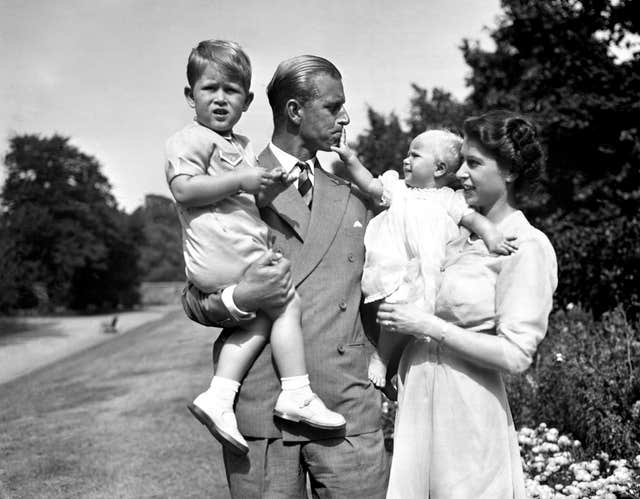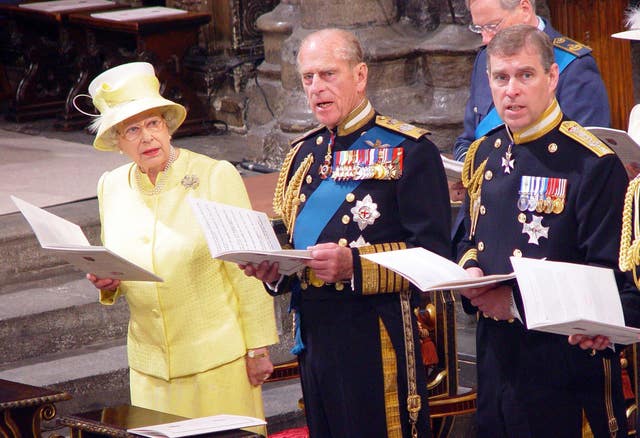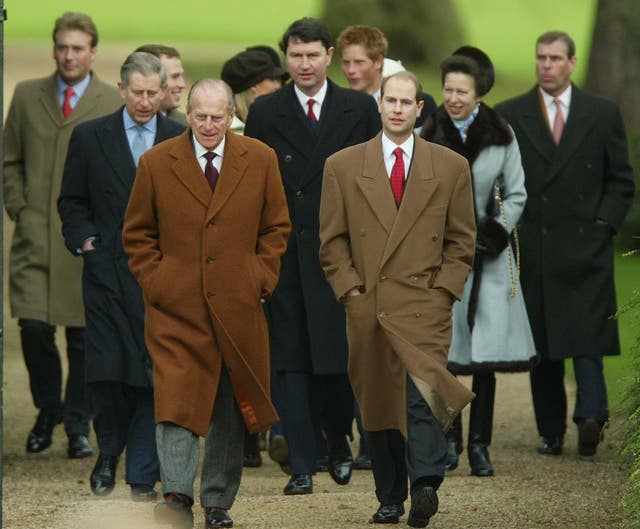
He was proud of all his children, but there was an element of tough love in the Duke of Edinburgh’s approach to parenthood.
Philip and Elizabeth produced an heir to the throne within a year of marrying and Charles Philip Arthur George was born on the evening of November 14 1948 in the Buhl Room at Buckingham Palace.
For the first time since the 18th century, there was no government minister present at the birth of a future heir to the throne.
Charles followed in his father’s footsteps by attending Cheam school in Berkshire and then Gordonstoun in Scotland.
But whereas Philip flourished amid Gordonstoun’s outdoors-focused regime, the Prince of Wales hated it and was bullied by the other boys.
The duke’s relationship with his eldest son was always thought to be the most difficult of all of his children.
Their outlook on life was markedly different.

Philip once declared: “He’s a romantic and I’m a pragmatist. That means we see things differently. And because I don’t see things as a romantic would, I’m unfeeling.”
The duke could be harsh. It was said he felt the sensitive prince needed to be toughened up – after all he would one day be king.
Unauthorised biographer Graham Turner claimed the duke thought Charles too precious and extravagant to be an efficient monarch.
According to Charles’s biographer, Jonathan Dimbleby, their relationship was not always an easy one.
The young prince seemed frightened of his father and was reduced to tears following public reprimands by the duke.
One observer concluded that the duke thought his son a bit of a wimp, and that Charles realised this, and was left deeply hurt.
Charles was said to have found open communication with his parents difficult.
Yet he recalled much happiness in his childhood and believed his father had tried his best, Dimbleby said.

He remembered how Philip had patiently taught him to make models, and how he had read Longfellow’s Hiawatha to him.
Philip showed his pride in all four children and believed they had done well under trying conditions.
He paid a public tribute to them during his golden wedding celebrations in 1997.
“Like all families, we went through the full range of the pleasures and tribulations of bringing up children.” he said.
“I am, naturally, somewhat biased, but I think our children have all done rather well under very difficult and demanding circumstances and I hope I can be forgiven for feeling proud of them.”
The duke also spoke of the responsibilities of being a royal and the “grey area of existence between official and what is left of private life”.
The Queen and Philip saw three of their four children divorce amid a blaze of publicity – the most acrimonious and high profile marriage breakdown being Charles and Diana’s War of the Waleses.
Whereas the duke’s relationship with Charles was at times reported to be strained, his bond with his only daughter was more solid.
Anne was the favourite and the pair were similarly matched.
She was born at Clarence House on August 15, 1950, and christened Anne Elizabeth Alice Louise in the Palace Music Room.

This princess was a tomboy and she grew to adopt the same harsh, no-nonsense ‘take-no-prisoners’ approach as her father.
“The key to the princess is that she is Prince Philip in skirts”, Lady Colin Campbell declared in her book The Royal Marriages.
After a gap of almost 10 years, Prince Andrew arrived at the Palace on February 19 1960, the first child to be born to a reigning monarch since Queen Victoria’s last, Princess Beatrice, in 1857.
He was christened Andrew Albert Christian Edward on April 8 1960, in the Music Room by the Archbishop of Canterbury.
The Duke of York served in the Falklands and despite his divorce managed to remain friends with his ex-wife Sarah, Duchess of York.
The Queen and the duke were unamused, however, when a topless Fergie was photographed having her toes sucked by her financial adviser.
The snapshots charting her poolside encounter were published in the newspapers while the duchess was staying at Balmoral with the rest of the royals. The remainder of the holiday was somewhat frosty, Sarah later recalled.

Andrew caused one of the worst scandals in modern royal history in November 2019 when he was forced to resign from royal duties over his association with convicted sex offender Jeffrey Epstein.
In an ill-advised Newsnight interview, the duke was criticised for showing a lack of empathy towards Epstein’s victims and a lack of remorse over his friendship with the disgraced financier, who took his own life while in prison.
As businesses and charities distanced themselves from Andrew, the Queen and Charles were said to have advised him to step down.
One of Epstein’s alleged victims Virginia Giuffre claims Andrew slept with her on three separate occasions, including when she was 17 – still a minor under US law.
The duke, who strongly denies the allegations, has faced calls to talk to the FBI.
Prince Edward was the royal couple’s fourth child, born at the Palace on March 10 1964, and christened Edward Antony Richard Louis on May 2 by the Dean of Windsor, Robert Woods, in the private chapel at Windsor Castle.
Unlike his brothers, Edward chose the Royal Marines for his stint in the services, pleasing the duke.
But Edward soon found he could not take the pace and dropped out.
The duke was left disappointed, but there was some suggestion that he was also rather pleased his youngest son had stood up to him and made his own choice.

He saw Edward – the most indulged of the four children – stage the embarrassing It’s A Royal Knockout!, fail in his attempt to run a successful television production firm, and finally quit the company to focus fully on royal duties.
The Earl of Wessex, who will eventually take on the title the Duke of Edinburgh, began to work closely with Philip in supporting his Duke of Edinburgh’s Award scheme, and the pair were said to get on well.
Edward’s daughter Lady Louise Mountbatten-Windsor was the first of the prince’s grandchildren to be given the duke’s family name Mountbatten – something denied to him when the Queen acceded to the throne.


Why are you making commenting on The National only available to subscribers?
We know there are thousands of National readers who want to debate, argue and go back and forth in the comments section of our stories. We’ve got the most informed readers in Scotland, asking each other the big questions about the future of our country.
Unfortunately, though, these important debates are being spoiled by a vocal minority of trolls who aren’t really interested in the issues, try to derail the conversations, register under fake names, and post vile abuse.
So that’s why we’ve decided to make the ability to comment only available to our paying subscribers. That way, all the trolls who post abuse on our website will have to pay if they want to join the debate – and risk a permanent ban from the account that they subscribe with.
The conversation will go back to what it should be about – people who care passionately about the issues, but disagree constructively on what we should do about them. Let’s get that debate started!
Callum Baird, Editor of The National
Comments: Our rules
We want our comments to be a lively and valuable part of our community - a place where readers can debate and engage with the most important local issues. The ability to comment on our stories is a privilege, not a right, however, and that privilege may be withdrawn if it is abused or misused.
Please report any comments that break our rules.
Read the rules here